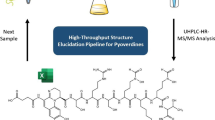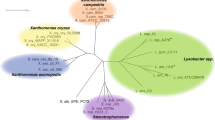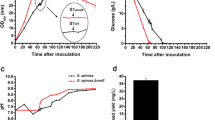Abstract
Metabolic profiling by capillary liquid chromatography-electrospray mass spectrometry was used to monitor shifts in the proferrioxamine profiles of Erwinia amylovora in response to externally supplied potential proferrioxamine precursors, selected stable-isotope-labeled precursors and atypical precursors. Based on the qualitative and quantitative shifts in the proferrioxamine profiles, lysine and arginine are unambiguous, and agmatine, ornithine, diaminobutyric acid and the corresponding C3–5 diamines are highly likely precursors for proferrioxamine biosynthesis in E. amylovora. 5-Hydroxylysine (Hyl), a recently discovered growth inhibitor for E. amylovora, suppresses proferrioxamine production. The Hyl-induced growth inhibition can be reversed by basic amino acids. The basic amino acids also partly restore proferrioxamine synthesis.
Similar content being viewed by others
References
Ankenbauer RG, Cox CD. 1988 Isolation and characterization of Pseudomonas aeruginosa mutants requiring salicylic acid for pyochelin biosynthesis. J Bacteriol 170, 5364–5367.
Bachrach U. 1962 Spermidine oxidase from Serratia marcescens. J Biol Chem 237, 3443–3448.
Bachrach U, Persky S, Razin S. 1960 Metabolism of amines. 2. The oxidation of natural polyamines by Mycobacterium smegmatis. Biochem J 76, 306–310.
Boelaert JR, Van Cutsem J, De Locht M, Schneider YJ, Crichton RR. 1994 Deferoxamine augments growth and pathogenicity of Rhizopus, while hydroxypyridine chelators have no effect. Kidney Int 45, 667–671.
Chambers CE, Sokol PA. 1994 Comparison of siderophore production and utilization in pathogenic and environmental isolates of Yersinia enterocolitica. J Clin Microbiol 32, 32–39.
Enard C, Diolez A, Expert D. 1988 Systemic virulence of Erwinia chrysanthemi 3937 requires a functional iron assimilation system. J Bacteriol 170 2419–2426.
Expert D, Gill PR. 1991 Iron: a modulator in bacterial virulence and symbiotic nitrogen fixation. In: Verma DAS, ed. Molecular Signals in Plant-Microbe Communications. Boca Raton: CRC Press; 229–245.
Feistner GJ, Staub CM. 1986 6-Thioguanine from Erwinia amylovora. Curr Microbiol 13, 95–101.
Feistner GJ, Gabrik AH, Beer SV. 1993a Application of capillary liquid chromatography-electrospray mass spectometry to identify major siderophores of Erwinia amylovora as proferrioxamines and their potential role in virulence. In: Kado CI, Crosa JH, eds. Molecular Mechanisms of Bacterial Virulence. Dordrecht: Kluwer; 429–444.
Feistner GJ, Stahl DC, Gabrik AH. 1993b Proferrioxamine siderophores of Erwinia amylovora. A capillary liquid chromatographic/electrospray tandem mass spectrometric study. Org Mass Spectrom 28, 163–175.
Feistner GJ. 1994a Growth inhibition of Erwinia amylovora. Pending patent PCT/US94/04002.
Feistner GJ. 1994b Profiling of bacterial metabolites by liquid chromatography-electrospray mass spectrometry: a perspective. Am Lab 26, 32L–32Q.
Feistner GJ. 1994c Profiling of basic amino acids and polyamines in microbial culture supernatants by electrospray mass spectrometry. Biol Mass Spectrom 23, 784–792.
Feistner GJ. 1994d Metabolism of polyamines and basic amino acids in Erwinia amylovora: application of liquid chromatography/ electrospray mass spectrometry to proferrioxamine precursor feeding and inhibition studies. Biol Mass Spectrom 23, 793–803.
Feistner GJ. 1995a Suggestion for a new, semirational nomenclature for the free chelators of ferrioxamines. Bio Metals 8, 193–196.
Feistner GJ. 1995b On the collision-activated fragmentation of proferrioxamines: evidence for a succinimide-mediated mechanism. J Am Soc Mass Spectrom, in press.
Griffiths E. 1993 Editorial iron and infection better understanding at the molecular level but little progress on the clinical front. J Med Microbiol 38, 389–390.
Hopfgartner G, Bean K, Henion J, Henry R. 1993 Ion spray mass spectrometric detection for liquid chromatography - a concentration-flow-sensitive or a mass-flow-sensitive device? J Chromatogr 647, 51–61.
Ikonomou MG, Blades AT, Kebarle P. 1990 Investigations of the electrospray interface for liquid chromatography/mass spectrometry. Anal Chem 62, 957–967.
Ishimaru CA, Loper JE. 1992 High-affinity iron uptake systems present in Erwinia carotovora subsp. carotovora include the hydroxamate siderophore aerobactin. J Bacteriol 174, 2993–3003.
Johnson KB, Stockwell VO, McLaughlin RJ, Sugar D, Loper JE, Roberts RG. 1993 Effect of antagonistic bacteria on establishment of honey bee-dispersed Erwinia amylovora in pear blossoms and on fire blight control. Phytopathology 83, 995–1002.
Lambrecht RS, Collins MT. 1993 Inability to detect mycobactin in Mycobacteria-infected tissues suggest an alternative iron acquisition mechanism by Mycobacteria in vivo. Microbial Pathogenesis 14, 229–238.
Leong SA, Neilands JB. 1981 Relationship of siderophore-mediated iron assimilation to virulence in crown gall disease. J Bacteriol 147, 482–491.
Mei B, Budde AD, Leong SA. 1993 sidl, a gene initiating siderophore biosynthesis in Ustilago maydis: Molecular characterization, regulation by iron, and role in phytopathogenicity. Proc Natl Acad Sci USA 90, 903–907.
Meives J, Fiedler H-P, Zähner H, Konetschny-Rapp S, Jung G. 1990 Production of desferrioxamine E and new analogues by directed fermentation and feeding fermentation. Appl Microbiol Biotechnol 32, 505–510.
Naumann K, Gierz R. 1992 Chancen und Grenzen einer Biologischen Bekämpfung des Feuerbrandes mit Hilfe bakterieller Antagonisten. In: Zeller W, ed. Wissenschaftliche Tagung über den Feuerbrand. Berlin: Kommissionsverlag Paul Parey; 54–58.
Neema C, Laulhere JP, Expert D. 1993 Iron deficiency induced by chrysobactin in saintpaulia leaves inoculated with Erwinia chrysanthemi. Plant Physiol 102, 967–973.
Razin S, Gery I, Bachrach U. 1959 The degradation of natural polyamines and diamines by bacteria. Biochem J 71, 551–558.
Schafft M, Diekmann H. 1978 Cadaverin ist ein Zwischenprodukt der Biosynthese von Arthrobactin und Ferrioxamin E. Arch Microbiol 117, 203–207.
Sneath BJ, Howson JM, Beer SV. 1990 Siderophore genes of Erwinia amylovora: cloning and putative role in virulence. Acta Horticult 273, 255–257.
Tabor CW, Dobbs LG. 1970 Metabolism of 1,4-diaminobutane and spermidine in Escherichia coli: the effects of low temperature during storage and harvesting of cultures. J Biol Chem 245, 2086–2091.
Tang L, Kebarle P. 1993 Dependence of ion intensity in electrospray mass spectrometry on the concentration of the analytes in the electrosprayed solution. Anal Chem 65, 3654–3668.
Vanneste JL, Expert D. 1990 Detection and characterization of an iron uptake system in E. amylovora. Acta Horticult 273, 249–253.
Vanneste JL, Paulin J-P, Expert D. 1990 Bacteriophage Mu as a genetic tool to study Erwinia amylovora pathogenicity and hypersensitive reaction on tobacco. J Bacteriol 172, 932–941.
Visca P, Serino L, Orsi N. 1992 Isolation and characterization of Pseudomonas aeruginosa mutants blocked in the synthesis of pyoverdin. J Bacteriol 174, 5727–5731.
Wilson M, Lindow SE. 1993 Interactions between the biological control agent Pseudomonas fluorescens A506 and Erwinia amylovora in pear blossoms. Phytopathology 83, 117–123.
Wodzinski RS, Umholtz TE, Rundle JR, Beer SV. 1994 Mechanisms of inhibition of Erwinia amylovora by Erwinia herbicola in vitro and in vivo. J Appl Bacteriol 76, 22–29.
Zeller W. 1992 Erfahrungen mit neueren bakteriziden Verbindungen gegen den Feuerbrand (Erwinia amylovora). In: Zeller W, ed. Wissenschaftliche Tagung über den Feuerbrand. Berlin: Kommissionsverlag Paul Parey; 44–47.
Author information
Authors and Affiliations
Rights and permissions
About this article
Cite this article
Feistner, G.J. Proferrioxamine synthesis in Erwinia amylovora in response to precursor or hydroxylysine feeding: metabolic profiling with liquid chromatography-electrospray mass spectrometry. Biometals 8, 318–327 (1995). https://doi.org/10.1007/BF00141605
Received:
Accepted:
Issue Date:
DOI: https://doi.org/10.1007/BF00141605




